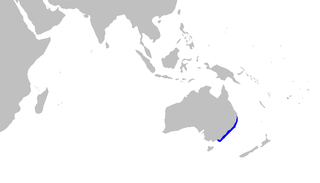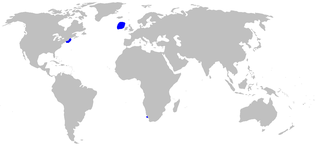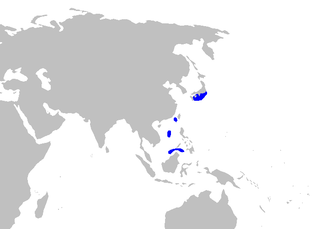
The brown catshark is commonly found in the Pacific Ocean, ranging from the northern Pacific waters off the coast of British Columbia and south to the Baja California peninsula in Mexico. They may live as far south as Ecuador and Peru. Brown catsharks are deep-water sharks that live on the outer continental shelf and the upper slope. They have been known to live at depths ranging from 30 to 650 m and live on the bottom, usually in muddy or sandy areas. The brown catshark, when originally described, was called Catulus brunneus.
The New Zealand catshark is a catshark of the family Scyliorhinidae in the order Carcharhiniformes. This species is endemic to in the deep waters around New Zealand. Its length is up to 45 centimetres (18 in). The New Zealand catshark is a small, little-known deep water bottom shark. It is dark brown around the top with a few widely spaced pale spots, and white below. It feeds on bottom-living crustaceans. It is also completely harmless to humans.
Aulohalaelurus is a genus of catsharks in the family Scyliorhinidae.

The Australian marbled catshark is a catshark of the family Scyliorhinidae, found in the eastern Indian Ocean, endemic to Western Australia between latitudes 12 and 21°S, from the surface to 245 m (800 ft) deep. Its length is up to 60.0 cm, and it typically inhabits coastal waters with sandy or rocky bottoms.

The banded sand catshark is a catshark of the family Scyliorhinidae found in the Indo-West Pacific Ocean, endemic to northern Australia between latitudes 10° S and 21° S, at depths between 27 and 120 metres. Its length is up to 45 centimetres (18 in).

The New Caledonia catshark or Kanakorum catshark is a catshark of the family Scyliorhinidae in the order Carcharhiniformes, known only from one specimen collected near southwestern New Caledonia in the western central Pacific Ocean. The holotype measured 79 cm (31 in). The New Caledonia catshark is a rare and vulnerable inshore catshark found around coral reefs.

The narrowmouthed catshark is a catshark of the family Scyliorhinidae, found from central Chile around the Straits of Magellan, to Argentina between latitudes 23° S and 56° S, at depths down to about 180 m (600 ft) in the Atlantic Ocean and about 360 m (1,200 ft) in the Pacific. It can grow to a length of up to 70 cm (28 in). The reproduction of this catshark is oviparous.

The Australian spotted catshark is a catshark of the family Scyliorhinidae, found only around Australia between 32 and 38°S, at depths between 10 and 180 m. It can grow up to 90 cm. Females of this species were observed as being reproductive year round. They are also confirmed as being a single oviparous species.

The orange-spotted catshark or rusty catshark, is a species of catshark, and part of the family Scyliorhinidae. It is found only off the coast of Western Australia, at depths between 25 and 540 m. Its length is up to 39 cm (15 in).

The blackspotted catshark is a catshark of the family Scyliorhinidae. It is found in the waters off the coasts of Japan, Korea, China, and Taiwan between latitudes 39° N and 20° N, at the depths of between 80 and 100 m. It can grow up to 49 cm in length.

The brownspotted catshark is a rare catshark of the family Scyliorhinidae, found in the Indo-West Pacific between latitudes 11° N and 12° S. Its juvenile length is about 38 cm, but its adult size is mostly unknown. The reproduction of this catshark is oviparous. The specific name garmani was dedicated to Samuel Walton Garman (1843–1927), renowned herpetologist and ichthyologist of the Museum of Comparative Zoology of Harvard University.

The Comoro catshark is a rare catshark of the family Scyliorhinidae. The holotype and only specimen was taken from the Comoros Islands in the Indian Ocean, at a depth of 400 m. The Comoro catshark is not well-documented. The reproduction of this catshark is oviparous.

The Panama ghost catshark is a lesser known catshark of the family Scyliorhinidae. This catshark is only found off Panama, between 9°N and 2°N. The reproduction of the Panama ghost shark is oviparous.

The South China catshark is a catshark of the family Scyliorhinidae, known only from the holotype, which was taken from the South China Sea at a depth of 537 m. Its length is 42 cm, but this measurement was taken from an immature specimen. The reproduction of the South China catshark is oviparous.

The Saldanha catshark is a species of catshark, belonging to the family Scyliorhinidae. This catshark is found from Cape Columbine to south of False Bay in South Africa, between 31 and 40°S. Its length is up to 88 cm. It is a plain, dark grey-brown, stout catshark, with moderately large eyes, a broad snout, and large pectoral fins.

The ghost catshark is a catshark of the family Scyliorhinidae found on the continental slopes in the northwest Atlantic off Massachusetts, the northeast Atlantic from the Porcupine Bank west of Ireland and the southern Atlantic off Cape Town, at depths between 600 and 1,900 metres.
The black roughscale catshark is a catshark of the family Scyliorhinidae. It is recorded from the north Atlantic, eastern South Atlantic, in the Indian Ocean and around Australia and New Zealand. The species can be found on continental shelf at depths between 510 and 1,520 m. It can grow up to 90 cm (35 in).

The spatulasnout catshark, also known as the Borneo catshark or flatnose catshark, is a catshark of the family Scyliorhinidae, found in the western Pacific between 35°N and 1° N. Its length is up to 80 cm.

The longnose catshark is a catshark of the family Scyliorhinidae found in the eastern central Pacific from central and southern California and the Gulf of California, between latitudes 38° N and 23° N, at depths down to 1,890. Its length is up to 58 cm.



















